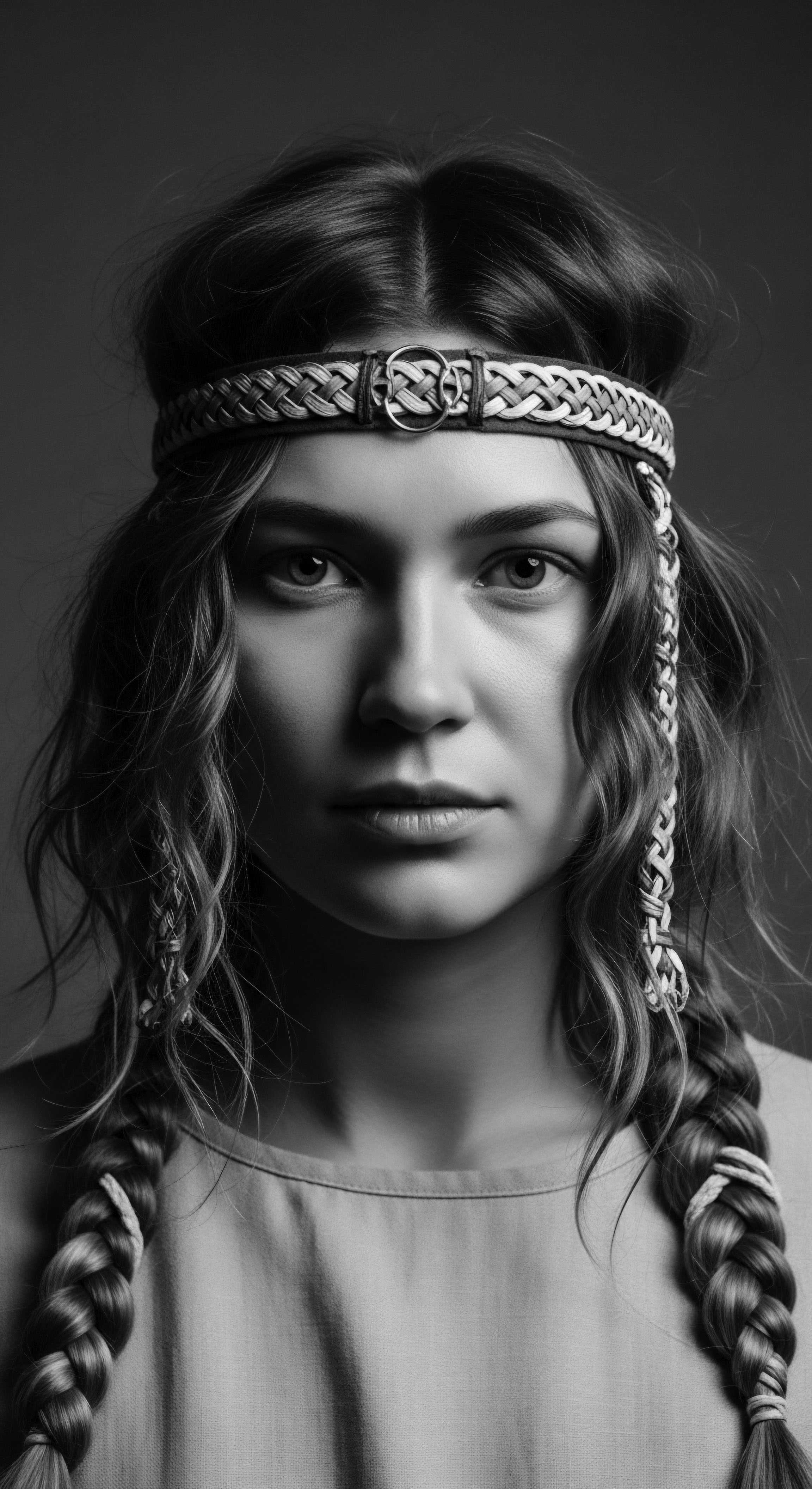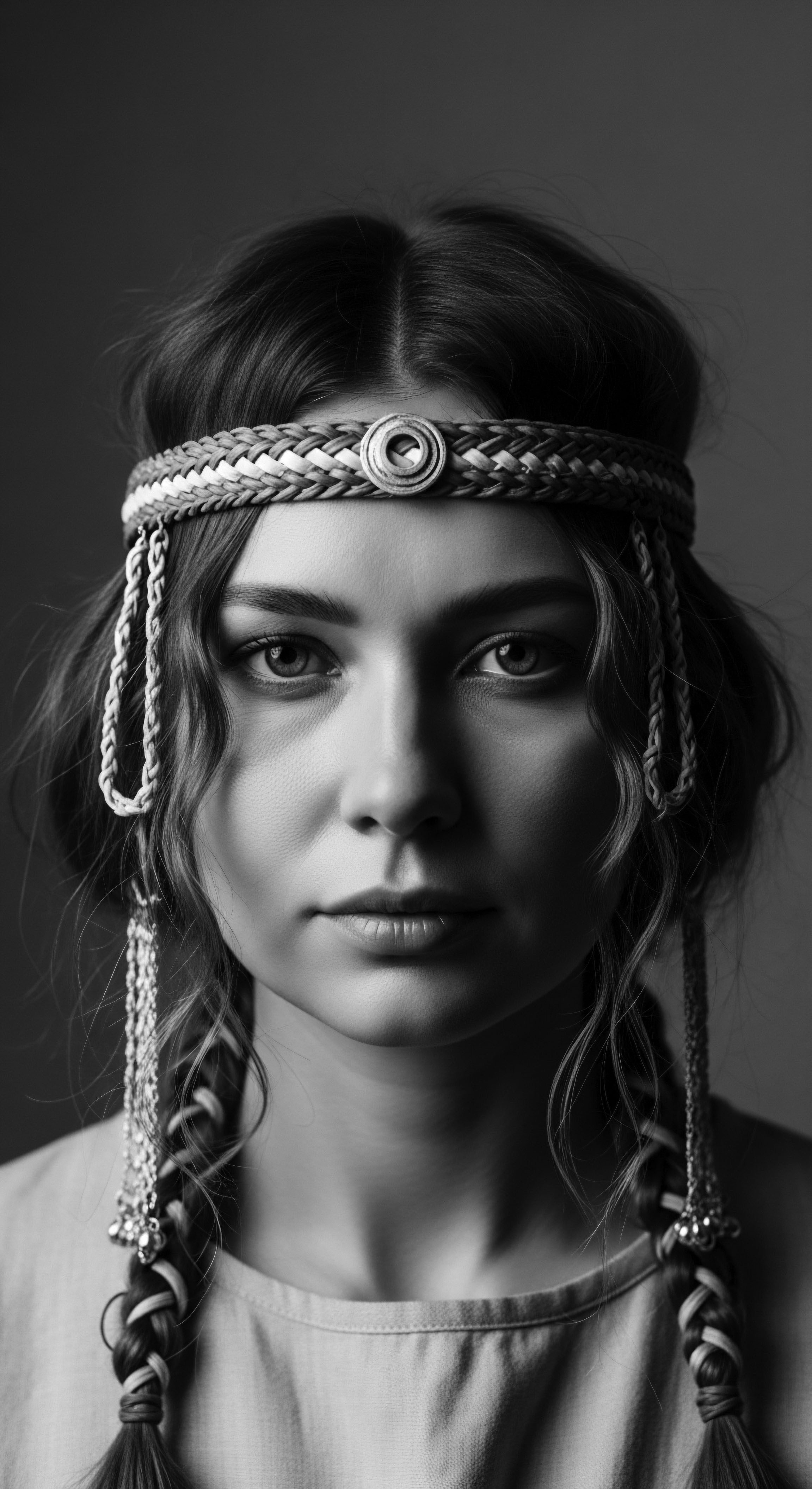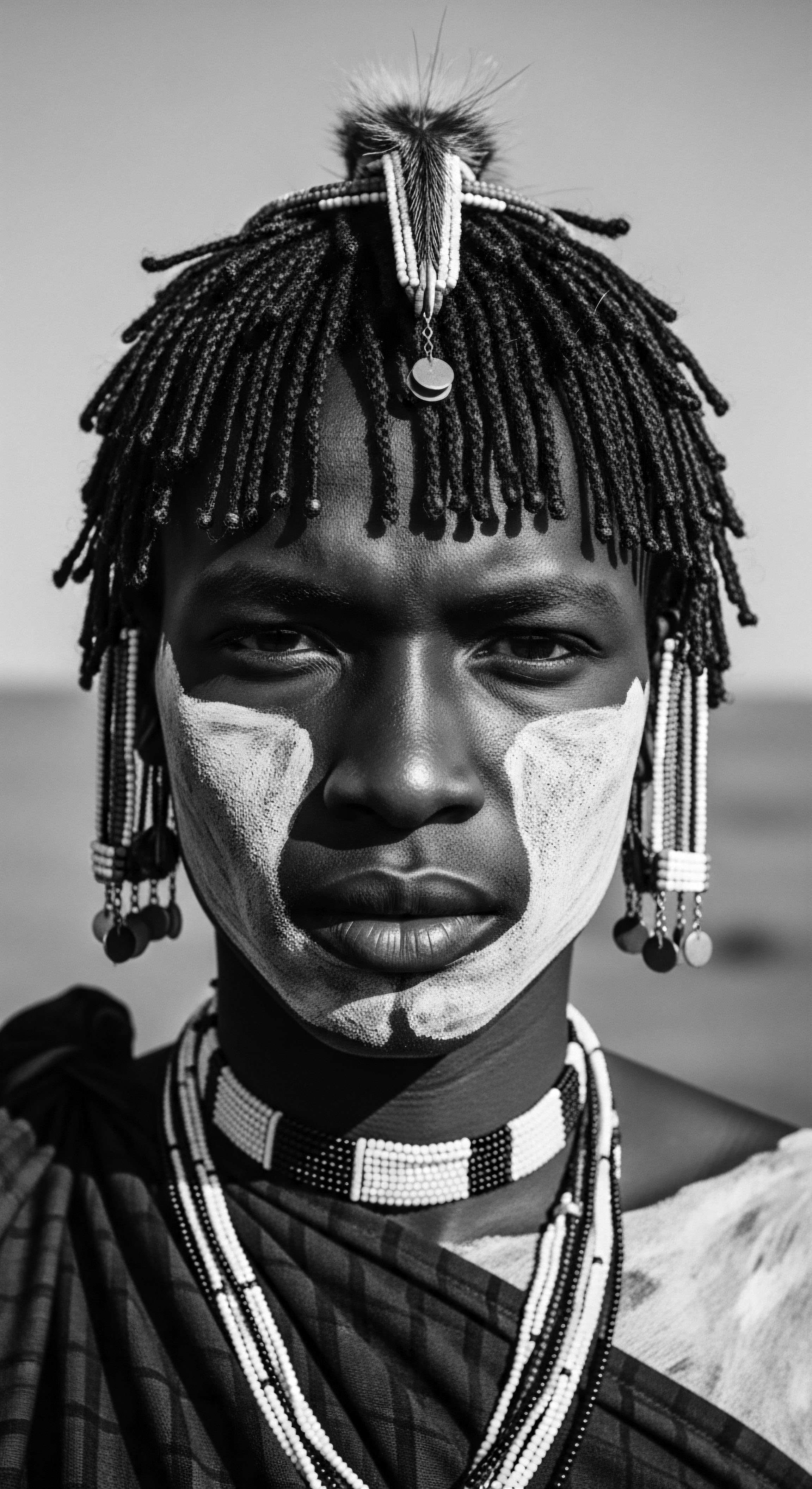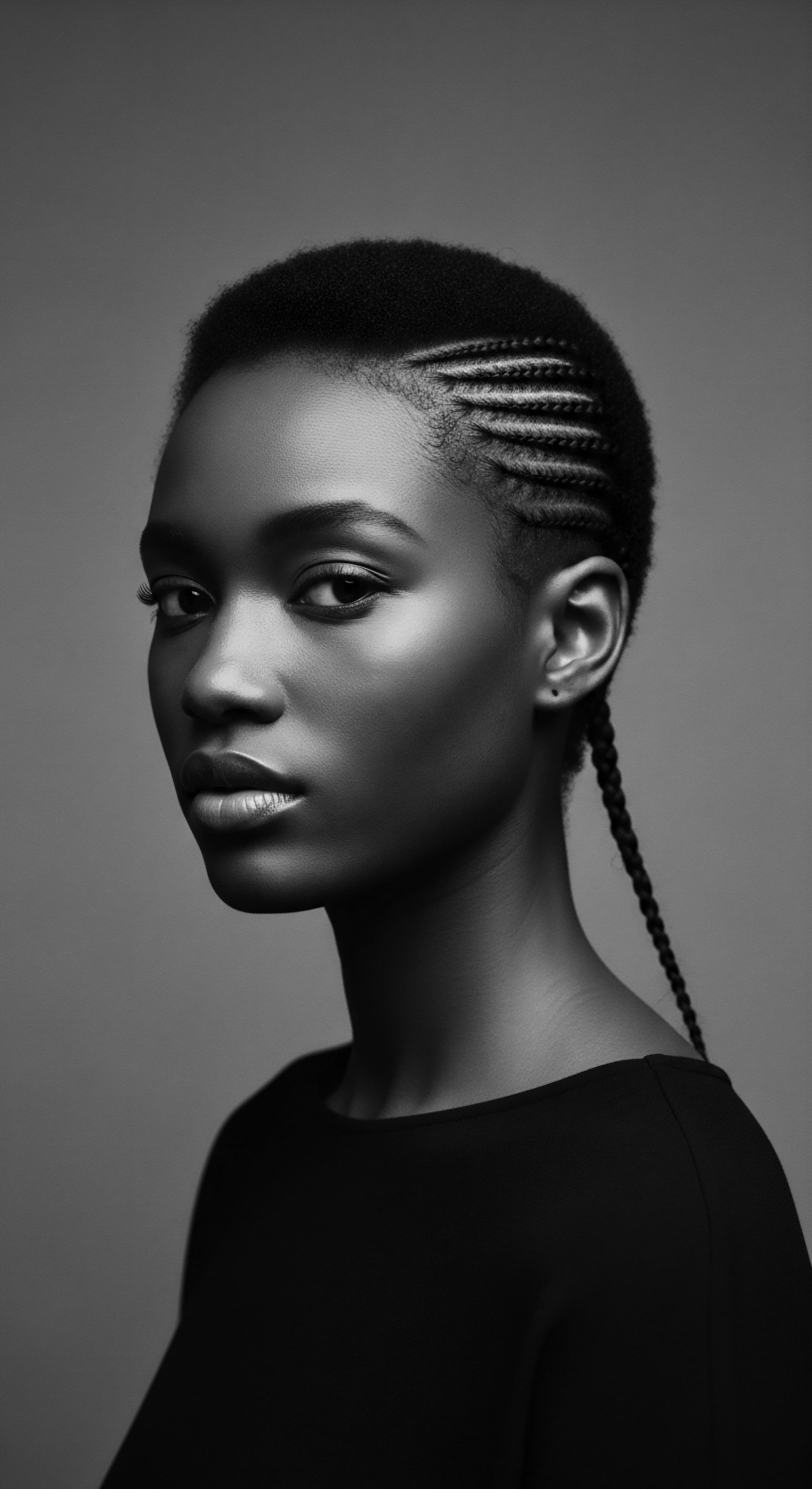
Fundamentals
The concept of Heritage Rituals, within the living library of Roothea, speaks to the profound connection between textured hair and the enduring wisdom of ancestral practices. It is not merely a collection of beauty regimens; rather, it is a comprehensive Explanation of the deeply rooted, intergenerational practices that have shaped the care, adornment, and cultural significance of hair across Black and mixed-race communities for centuries. This foundational Definition acknowledges hair as a living extension of identity, a canvas for storytelling, and a sacred link to lineage.
At its most fundamental level, Heritage Rituals encompasses the time-honored traditions passed down through families and communities, offering a framework for understanding how textured hair has been nurtured, protected, and celebrated. These rituals involve more than just physical care; they embody a holistic approach to wellbeing, where the act of tending to hair becomes a mindful, spiritual, and communal experience. From the careful selection of natural ingredients harvested from the earth to the intricate braiding patterns that convey stories and status, each gesture holds a historical Meaning, a testament to resilience and creative spirit.
Heritage Rituals are the ancestral practices and communal wisdom that connect textured hair to identity, resilience, and intergenerational understanding.

The Roots of Care ❉ Elemental Beginnings
Long before modern science dissected the protein structures of hair, ancestral communities possessed an intuitive Understanding of its elemental biology. They observed the hair’s natural inclination to coil, to shrink, to seek moisture, and they devised methods of care that honored these inherent characteristics. The initial care practices were often simple, drawing directly from the immediate environment.
Plant-based oils, butters, and infusions were regularly applied to seal moisture, impart shine, and maintain suppleness. These early approaches, though seemingly basic, formed the bedrock of sophisticated systems of hair maintenance.
The earliest forms of these rituals involved hands working with natural resources, fostering a tactile connection to the earth and its offerings. Preparing a hair balm from shea butter, for instance, involved knowledge of the tree, the nut, and the precise technique for extracting its nourishing properties. This process was often communal, a gathering of hands and voices, solidifying social bonds through shared labor and transmitted knowledge.

Hair as a Chronicle ❉ Beyond the Strand
The simple act of hair care held a much broader Significance in ancient societies. Hair served as a visual chronicle of a person’s life, reflecting their age, marital status, social standing, and even their tribal affiliation. Intricate styles communicated messages without a single word being spoken, a living language woven into the very strands. This communal understanding of hair as a form of expression transformed daily grooming into a ritualistic act of identity affirmation.
Consider the myriad ways hair could speak ❉
- Age Markers ❉ Different styles designated childhood, adolescence, adulthood, or elder status.
- Social Standing ❉ Elaborate coiffures often indicated leadership roles or elevated positions within a community.
- Marital Status ❉ Specific arrangements of braids or adornments might announce a person’s availability for marriage or their commitment.
- Tribal Affiliation ❉ Distinct patterns served as identifiers, allowing members of different groups to recognize one another.
These nuanced visual cues provided a rich layer of social information, making hair an undeniable part of a person’s public presentation and communal belonging.

Intermediate
Moving beyond foundational principles, the intermediate Interpretation of Heritage Rituals delves into the dynamic interplay between ancient practices and the enduring spirit of Black and mixed-race communities. This deeper exploration recognizes Heritage Rituals as a continuous thread of cultural preservation, a resilient response to historical challenges, and a vibrant expression of collective identity. The daily acts of hair care transform into profound affirmations of self and lineage, embodying a sacred connection to the past while actively shaping the present.
The tender thread of these rituals extends through generations, often surviving periods of immense upheaval and attempts at cultural erasure. Even when traditional languages or customs were suppressed, the practices surrounding hair often persisted, adapted, and continued to carry deep communal Meaning. This resilience speaks to the intrinsic value placed on hair within these cultures, viewing it not merely as an aesthetic feature but as a spiritual antenna, a repository of ancestral memory, and a conduit for connection to the divine.

The Tender Thread ❉ Living Traditions and Community
Within the historical journey of textured hair, the act of tending to one another’s crowns became a powerful communal ritual. It was a space for sharing stories, transmitting wisdom, and forging unbreakable bonds. These gatherings, often taking place in intimate settings like family homes or communal courtyards, were informal schools where younger generations learned the intricate techniques of braiding, twisting, and oiling, alongside the deeper cultural narratives associated with each style. The physical closeness fostered emotional connection, transforming hair care into a truly holistic practice.
The shared experience of hair grooming served as a vital mechanism for cultural continuity. Through the rhythmic motion of fingers on strands, grandmothers passed down not only styling methods but also the songs, proverbs, and historical accounts that gave those styles their profound Significance. This intergenerational exchange ensured that the spirit of these traditions remained alive, even when external forces sought to diminish their visibility.
Hair grooming became a communal ritual, a sacred space for intergenerational exchange, where wisdom and cultural narratives were woven into each strand.

Traditional Ingredients and Their Enduring Efficacy
Ancestral hair care was intrinsically linked to the natural world, with indigenous knowledge guiding the selection and preparation of ingredients. These were not arbitrary choices; they were based on centuries of observation and empirical testing within specific ecosystems. Modern scientific inquiry often provides compelling validation for these long-standing practices, demonstrating how the chemical compounds within traditionally used plants and minerals offer genuine benefits for hair health.
Consider the remarkable case of Chebe Powder, traditionally used by the Basara women of Chad. This natural blend of ingredients, including the Croton zambesicus plant, cloves, and other spices, has been attributed to their impressive hair length and strength for centuries. Women of the Basara tribe apply this powder, mixed with oils, to their hair, focusing on the lengths rather than the scalp, to prevent breakage and retain moisture.
This traditional regimen aligns with contemporary understanding of moisture retention as a key factor in minimizing hair damage and promoting length retention, particularly for highly textured hair prone to dryness. The practice highlights a sophisticated, ancestral Delineation of hair care principles.
| Traditional Ingredient Shea Butter (Vitellaria paradoxa) |
| Ancestral Application Nourishing balm, sealant, protective layer against environmental elements. |
| Contemporary Understanding / Benefit Rich in fatty acids and vitamins (A, E, F), provides deep moisture, reduces frizz, and protects against heat damage. |
| Traditional Ingredient Coconut Oil (Cocos nucifera) |
| Ancestral Application Conditioning treatment, scalp stimulant, used for shine and softness. |
| Contemporary Understanding / Benefit Penetrates the hair shaft to reduce protein loss, offers antibacterial properties for scalp health, and imparts luster. |
| Traditional Ingredient Aloe Vera (Aloe barbadensis miller) |
| Ancestral Application Soothing agent for scalp irritation, moisturizing conditioner. |
| Contemporary Understanding / Benefit Contains proteolytic enzymes that repair dead skin cells on the scalp, acts as a great conditioner, and promotes hair growth. |
| Traditional Ingredient Chebe Powder (Croton zambesicus, etc.) |
| Ancestral Application Hair mask for length retention and strength, applied to hair strands. |
| Contemporary Understanding / Benefit Believed to strengthen hair, reduce breakage, and aid in moisture retention, leading to increased length. |
| Traditional Ingredient These examples demonstrate how ancestral wisdom, passed down through Heritage Rituals, often predates and parallels modern scientific findings in hair care. |

Hair as a Symbol of Resistance and Identity
The journey of textured hair through history is also a testament to its role as a symbol of resistance. During periods of oppression, particularly the transatlantic slave trade, hair became a site of profound cultural defiance. Enslaved Africans, stripped of their names, languages, and traditional adornments, found ways to maintain a connection to their heritage through their hair. The meticulous care of hair, even under the most brutal conditions, became an act of self-preservation and a silent protest against dehumanization.
The Afro of the 1960s Civil Rights Movement serves as a powerful modern echo of this historical resistance. It was a conscious rejection of Eurocentric beauty standards and a bold assertion of Black pride and identity. This deliberate choice to wear hair in its natural, unbound state was a political statement, a visual declaration of self-acceptance and solidarity. This period marks a pivotal moment in the contemporary understanding of Heritage Rituals, highlighting hair as a potent medium for social commentary and self-determination.

Academic
The academic Delineation of Heritage Rituals posits it as a complex, multi-layered socio-cultural construct, intricately woven into the biological specificities of textured hair and the historical trajectories of Black and mixed-race diasporic communities. It is a scholarly lens through which we scrutinize the interplay of ancestral knowledge systems, material culture, psychological well-being, and collective identity as manifested through hair practices. This comprehensive Explanation transcends mere description, seeking to uncover the deep epistemological and ontological Meaning embedded within these enduring traditions. Heritage Rituals, in this academic context, represents the cumulative, intergenerational transmission of adaptive strategies for hair care, simultaneously serving as a powerful medium for cultural memory, resistance, and self-affirmation against systemic pressures.
A rigorous examination of Heritage Rituals requires an interdisciplinary approach, drawing insights from anthropology, ethnobotany, sociology, psychology, and hair science. This analytical framework allows for a granular dissection of how elemental biology, historical oppression, and cultural ingenuity converge within the practices surrounding textured hair. The persistent practice of these rituals, even in the face of concerted efforts to suppress them, speaks to their fundamental role in sustaining collective identity and fostering resilience within marginalized populations.

Echoes from the Source ❉ Biological and Ancient Underpinnings
From a biological standpoint, textured hair, characterized by its helical structure, varying curl patterns, and often high porosity, presents unique physiological needs that ancestral practices instinctively addressed. The tight coiling of hair strands means natural oils produced by the scalp struggle to travel down the entire length, leading to dryness and susceptibility to breakage. Ancient hair care regimens, therefore, often centered on methods of moisture retention and fortification.
The application of plant-based oils, butters, and clays, as observed in various African traditions, served as natural emollients and sealants, directly mitigating these biological challenges. This practical application of empirical observation speaks to an ancient, embodied science of hair care.
Early evidence of sophisticated hair practices dates back millennia. Archaeological findings and historical accounts from ancient Egypt, for instance, depict elaborate wigs and braided styles that communicated social status and religious beliefs. In many African societies, hair was a powerful symbolic tool, conveying messages about social standing, ethnicity, marital status, and even spiritual beliefs. The intricate braiding techniques themselves were not merely aesthetic endeavors; they represented a profound artistic skill, often passed down through generations within families, serving as a testament to the enduring cultural Specification of hair as an art form.

Hair as a Repository of Coded Knowledge
The academic lens reveals how hair, beyond its biological and aesthetic attributes, served as a profound repository of coded knowledge and a clandestine communication system, particularly during periods of extreme duress. The transatlantic slave trade represents a harrowing chapter where this function of hair reached its most poignant expression. Enslaved Africans, systematically stripped of their cultural markers—their languages, their traditional attire, their very names—clung to their hair as one of the few remaining canvases for self-expression and cultural continuity.
A compelling historical example, rigorously documented through oral traditions and cultural studies, illustrates this profound connection ❉ the use of Cornrows as Covert Maps and Carriers of Sustenance during the Transatlantic Slave Trade and Subsequent Escapes. In communities across the Americas, particularly in regions like Colombia, enslaved women ingeniously braided intricate patterns into their hair, which served as topographical maps detailing escape routes through plantations and wilderness to freedom. These complex patterns, often indistinguishable to the uninitiated eye, contained critical information ❉ the direction of rivers, the location of safe houses, or the pathways through dense foliage. Moreover, some accounts indicate that seeds, rice grains, or even gold fragments were occasionally woven into these tightly braided styles, providing vital sustenance or a means of survival for those undertaking perilous journeys to liberty.
This practice, a powerful act of resistance and ingenuity, underscores the profound Significance of hair as a living archive of defiance and survival. It was a tangible manifestation of ancestral wisdom, transforming a biological feature into a tool for liberation. (Rosado, 2003, p. 61) states that hair grooming practices and African aesthetics in hairstyles throughout the diaspora are anthropologically relevant due to the socio-cultural role hair continues to play among Black people.

The Unbound Helix ❉ Identity, Resistance, and Futures
The journey of textured hair through history is a testament to its dynamic role in voicing identity and shaping futures. The forced imposition of Eurocentric beauty standards during colonialism and slavery led to profound psychological impacts, often fostering internalized racism and a devaluation of natural hair textures. The “good hair” versus “bad hair” dichotomy, a legacy of these oppressive systems, compelled many to chemically alter their hair, sacrificing health for societal acceptance. This historical trauma highlights the deeply political nature of hair and the urgent need for its reclamation.
The mid-20th century witnessed a powerful resurgence of natural hair, particularly with the rise of the Civil Rights and Black Power movements. The Afro became a potent symbol of Black pride, self-acceptance, and a direct challenge to oppressive beauty norms. This cultural shift marked a collective assertion of identity, where hair became a visible declaration of heritage and a rejection of assimilationist pressures. This period illustrates how Heritage Rituals are not static relics of the past but living, evolving practices that adapt to contemporary struggles for self-determination.

The CROWN Act and Beyond ❉ Legal and Social Recognitions
The ongoing struggle against hair discrimination in modern society further solidifies the academic Clarification of Heritage Rituals as a matter of human rights and social justice. Legislation such as the CROWN (Creating a Respectful and Open World for Natural Hair) Act, first passed in California in 2019 and subsequently in many other U.S. states, explicitly prohibits discrimination based on hair texture and protective hairstyles associated with racial or ethnic identity. These legal protections are a direct response to documented instances of discrimination in schools and workplaces, where Black individuals have faced punitive measures for wearing their natural hair or traditional styles.
The existence and necessity of such legislation underscore the persistent societal biases against textured hair and the profound psychological toll this discrimination exacts. Research indicates that negative experiences related to hair are normative for young Black girls, leading to feelings of shame, low self-esteem, anxiety, and even chronic stress. This underscores the critical Import of Heritage Rituals not only for cultural affirmation but also for mental and emotional well-being.
The work of pioneers like Dr. Willie Morrow stands as a testament to the intersection of science, entrepreneurship, and cultural advocacy within the realm of textured hair care. Dr. Morrow, a self-taught chemist and barber, invented the widely used Afro pick and developed products like the “California Curl” that provided gentler alternatives for styling Black hair, contributing significantly to the Black beauty industry.
His innovations were not merely commercial ventures; they were direct responses to the specific needs of textured hair, often overlooked by mainstream industries, providing practical solutions that empowered individuals to care for their hair in ways that honored its natural characteristics. His efforts represent a practical Designation of how knowledge, both traditional and scientific, can serve the community.

Future Trajectories ❉ Sustaining the Living Archive
The academic study of Heritage Rituals also considers their future trajectories. As global communities become increasingly interconnected, there is a renewed emphasis on preserving and revitalizing traditional practices, ensuring their continued relevance for new generations. This involves not only documenting historical methods but also adapting them with contemporary scientific understanding to address modern hair care challenges and environmental concerns. The ongoing dialogue between ancestral wisdom and scientific discovery offers a fertile ground for innovation, fostering products and practices that are both effective and culturally resonant.
The continuous Explication of Heritage Rituals contributes to a broader cultural literacy, fostering appreciation for the diversity of human expression and the resilience of identity. It champions a holistic view of beauty that is deeply rooted in authenticity, self-acceptance, and a profound respect for the legacy carried within each strand of textured hair. This intellectual pursuit ultimately serves to affirm the inherent value and beauty of Black and mixed-race hair experiences, positioning them as central to the global narrative of human heritage.

Reflection on the Heritage of Heritage Rituals
The journey through Heritage Rituals, from its elemental biological roots to its contemporary manifestations, reveals a profound truth ❉ textured hair is far more than a physical attribute. It stands as a living, breathing archive, holding centuries of stories, struggles, and triumphs within its coils and kinks. Each carefully applied oil, every precise part in a braid, and every shared moment of grooming contributes to an unbroken lineage of wisdom and resilience. This continuous act of tending to hair is a quiet, yet powerful, testament to the enduring spirit of communities that have consistently found ways to affirm their identity and celebrate their unique beauty, even in the face of systemic adversity.
The Soul of a Strand ethos, therefore, finds its deepest resonance within these rituals. It is the recognition that hair is not separate from self, nor from history. Instead, it is an extension of ancestral memory, a vibrant connection to those who came before, and a guiding force for those yet to come.
By engaging with Heritage Rituals, we participate in a sacred conversation across time, honoring the ingenuity of our forebears and affirming the inherent dignity of our own hair. This ongoing legacy reminds us that true beauty blossoms from authenticity, from the deep roots of heritage, and from the unwavering commitment to care for what is truly ours.

References
- Akanmori, M. (2015). The Cultural Significance of Hair in African Societies. University of Ghana Press.
- Byrd, A. D. & Tharps, L. (2014). Hair Story ❉ Untangling the Roots of Black Hair in America. St. Martin’s Press.
- Essel, S. (2023). Hair and Identity in African Traditional Culture. Africa World Press.
- Harris, P. (2017). The Hair That Grew from the Roots ❉ A Cultural History of Black Hair. Black Classic Press.
- Omotos, A. (2018). Hair in African Art and Culture. Journal of Pan African Studies.
- Rosado, S. (2003). Hair as Language ❉ The Socio-Cultural Significance of Black Women’s Hair. Routledge.
- Sieber, R. & Herreman, F. (2000). Hair in African Art and Culture. The Museum for African Art.
- Turner, P. (2001). Crafting a Life ❉ African American Women’s Hair and Self-Fashioning. University of Pennsylvania Press.
- Walker, S. S. (1992). The Politics of Hair ❉ Hair and the Black Woman’s Identity. Black Arts Movement Press.
- Zeleza, P. T. (2005). The African Diaspora ❉ A History Through Culture. Indiana University Press.
